第十周web作業
作業一、For each in,For in和For of(explain,examples)
一、一般的遍歷數組的方法:
var array = [1,2,3,4,5,6,7];
for (var i = 0; i < array.length; i) {
console.log(i,array[i]);
}
二、用for in的方遍歷數組
for(let index in array) {
console.log(index,array[index]);
};
三、forEach


array.forEach(v=>{
console.log(v);
});
array.forEach(function(v){
console.log(v);
});


四、用for in不僅可以對數組,也可以對enumerable對象操作
var A = {a:1,b:2,c:3,d:"hello world"};
for(let k in A) {
console.log(k,A[k]);
}
五、在ES6中,增加了一個for of循環,使用起來很簡單


for(let v of array) {
console.log(v);
}; let s = "helloabc";
for(let c of s) {
console.log(c);
}


總結來說:for in總是得到對像的key或數組,字符串的下標,而for of和forEach一樣,是直接得到值
結果for of不能對象用
對於新出來的Map,Set上面


var set = new Set();
set.add("a").add("b").add("d").add("c");
var map = new Map();
map.set("a",1).set("b",2).set(999,3);
for (let v of set) {
console.log(v);
}
console.log("--------------------");
for(let [k,v] of map) {
console.log(k,v);
} 

javascript遍歷對象詳細總結
1.原生javascript遍歷
(1)for循環遍歷
let array1 = [‘a‘,‘b‘,‘c‘];
for (let i = 0;i < array1.length;i++){
console.log(array1[i]); // a b c
}
(2)JavaScript 提供了 foreach() map() 兩個可遍歷 Array對象 的方
forEach和map用法類似,都可以遍歷到數組的每個元素,而且參數一致;
Array.forEach(function(value , index , array){ //value為遍歷的當前元素,index為當前索引,array為正在操作的數組
//do something
},thisArg) //thisArg為執行回調時的this值
不同點:
forEach() 方法對數組的每個元素執行一次提供的函數。總是返回undefined;
map() 方法創建一個新數組,其結果是該數組中的每個元素都調用一個提供的函數後返回的結果。返回值是一個新的數組;
例子如下:


var array1 = [1,2,3,4,5];
var x = array1.forEach(function(value,index){
console.log(value); //可遍歷到所有數組元素
return value + 10
});
console.log(x); //undefined 無論怎樣,總返回undefined
var y = array1.map(function(value,index){
console.log(value); //可遍歷到所有數組元素
return value + 10
});
console.log(y); //[11, 12, 13, 14, 15] 返回一個新的數組


對於類似數組的結構,可先轉換為數組,再進行遍歷


let divList = document.querySelectorAll(‘div‘); //divList不是數組,而是nodeList
//進行轉換後再遍歷
[].slice.call(divList).forEach(function(element,index){
element.classList.add(‘test‘)
})
Array.prototype.slice.call(divList).forEach(function(element,index){
element.classList.remove(‘test‘)
})
[...divList].forEach(function(element,index){ //<strong>ES6寫法</strong>
//do something
})


(3)for ··· in ··· / for ··· of ···
for...in 語句以任意順序遍歷一個對象的可枚舉屬性。對於每個不同的屬性,語句都會被執行。每次叠代時,分配的是屬性名
補充 : 因為叠代的順序是依賴於執行環境的,所以數組遍歷不一定按次序訪問元素。 因此當叠代那些訪問次序重要的 arrays 時用整數索引去進行 for 循環 (或者使用 Array.prototype.forEach() 或 for...of 循環) 。


let array2 = [‘a‘,‘b‘,‘c‘]
let obj1 = {
name : ‘lei‘,
age : ‘16‘
}
for(variable in array2){ //variable 為 index
console.log(variable ) //0 1 2
}
for(variable in obj1){ //variable 為屬性名
console.log(variable) //name age
}


ES6新增了 遍歷器(Iterator)機制,為不同的數據結構提供統一的訪問機制。只要部署了Iterator的數據結構都可以使用 for ··· of ··· 完成遍歷操作 ( Iterator詳解 : http://es6.ruanyifeng.com/#docs/iterator ),每次叠代分配的是 屬性值
原生具備 Iterator 接口的數據結構如下:
Array Map Set String TypedArray 函數的arguments對象 NodeList對象


let array2 = [‘a‘,‘b‘,‘c‘]
let obj1 = {
name : ‘lei‘,
age : ‘16‘
}
for(variable of array2){ //<strong>variable 為 value</strong>
console.log(variable ) //‘a‘,‘b‘,‘c‘
}
for(variable of obj1){ //<strong>普通對象不能這樣用</strong>
console.log(variable) // 報錯 : main.js:11Uncaught TypeError: obj1[Symbol.iterator] is not a function
}<br><br>let divList = document.querySelectorAll(‘div‘);<br><br>for(element of divlist){ //可遍歷所有的div節點<br> //do something <br>}


如何讓普通對象可以用for of 進行遍歷呢? http://es6.ruanyifeng.com/#docs/iterator 一書中有詳細說明了!
除了叠代時分配的一個是屬性名、一個是屬性值外,for in 和 for of 還有其他不同 (MDN文檔: https://developer.mozilla.org/zh-CN/docs/Web/JavaScript/Reference/Statements/for...of)
for...in循環會遍歷一個object所有的可枚舉屬性。
for...of會遍歷具有iterator接口的數據結構
for...in 遍歷(當前對象及其原型上的)每一個屬性名稱,而 for...of遍歷(當前對象上的)每一個屬性值


Object.prototype.objCustom = function () {};
Array.prototype.arrCustom = function () {};
let iterable = [3, 5, 7];
iterable.foo = "hello";
for (let i in iterable) {
console.log(i); // logs 0, 1, 2, "foo", "arrCustom", "objCustom"
}
for (let i of iterable) {
console.log(i); // logs 3, 5, 7
}
 第一個作業借鑒於:https://www.cnblogs.com/amujoe/p/8875053.html
作業二、constructor vs object source
constructor的定義和用法:constructor 屬性返回對創建此對象的數組函數的引用。 語法:object.constructor
舉例說明constructor屬性:
第一個作業借鑒於:https://www.cnblogs.com/amujoe/p/8875053.html
作業二、constructor vs object source
constructor的定義和用法:constructor 屬性返回對創建此對象的數組函數的引用。 語法:object.constructor
舉例說明constructor屬性:
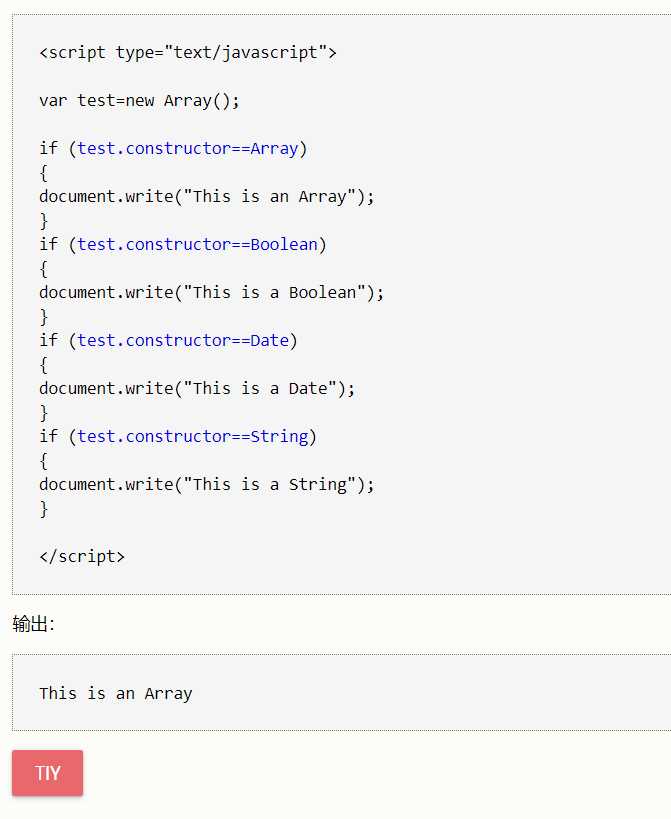
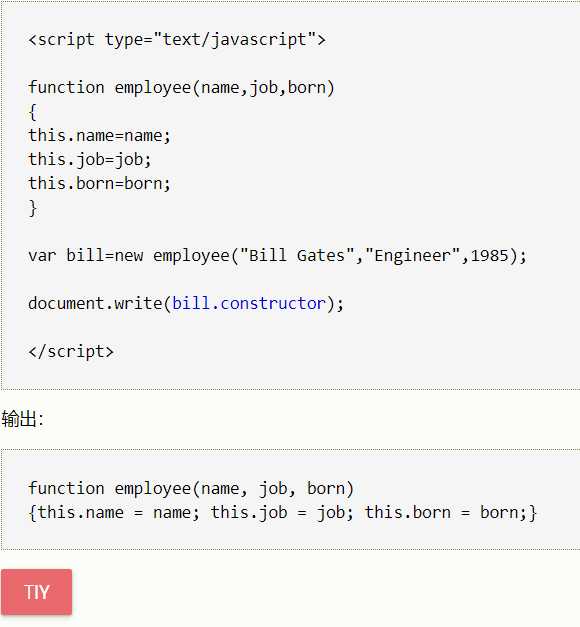 作業三、Arrow function restore
箭頭函數表達式的語法比函數表達式短,並且不綁定自己的 this,arguments,super或 new.target。此外,箭頭函數最好在非方法函數中使用,且不能用作構造函數。
語法:
1.基礎語法:
(param1, param2, …, paramN) => { statements }
(param1, param2, …, paramN) => expression
// 等價於: => { return expression; }
// 如果只有一個參數,圓括號是可選的:
(singleParam) => { statements }
singleParam => { statements }
// 無參數或者多參數的箭頭函數需要使用圓括號或者下劃線:
() => { statements } _ => { statements }
2.高級語法:
// 只返回一個對象字面量,沒有其他語句時, 應當用圓括號將其包起來:
params => ({foo: bar})
// 支持 Rest parameters 和 default parameters:
(param1, param2, ...rest) => { statements }
(param1 = defaultValue1, param2, …, paramN = defaultValueN) => { statements }
// 支持參數列表中的解構賦值
var f = ([a, b] = [1, 2], {x: c} = {x: a + b}) => a + b + c; f(); // 6
箭頭函數的引入有兩個方面的作用:一是更簡短的函數書寫,二是對 this的詞法解析。
1.更短的函數:
var a = [ "Hydrogen", "Helium", "Lithium", "Beryl-lium" ];
var a2 = a.map(function(s){ return s.length });
var a3 = a.map( s => s.length );
2.不綁定this:
function Person() {
// 構造函數 Person() 定義的 `this` 就是新實例對象自己
this.age = 0;
setInterval(function growUp() {
// 在非嚴格模式下,growUp() 函數定義了其內部的 `this`為全局對象, 不同於構造函數Person()的定義的 `this`
this.age++; }
, 1000);
}
var p = new Person();
// 在 ECMAScript 3/5 中,這個問題通過把this的值賦給變量,
// 然後將該變量放到閉包中來解決。
function Person() {
var self = this; // 也有人選擇使用 `that` 而非 `self`.
// 只要保證一致就好.
self.age = 0;
setInterval(function growUp() {
// 回調裏面的 `self` 變量就指向了期望的那個對象了
self.age++; }
, 1000);
}
作業三、Arrow function restore
箭頭函數表達式的語法比函數表達式短,並且不綁定自己的 this,arguments,super或 new.target。此外,箭頭函數最好在非方法函數中使用,且不能用作構造函數。
語法:
1.基礎語法:
(param1, param2, …, paramN) => { statements }
(param1, param2, …, paramN) => expression
// 等價於: => { return expression; }
// 如果只有一個參數,圓括號是可選的:
(singleParam) => { statements }
singleParam => { statements }
// 無參數或者多參數的箭頭函數需要使用圓括號或者下劃線:
() => { statements } _ => { statements }
2.高級語法:
// 只返回一個對象字面量,沒有其他語句時, 應當用圓括號將其包起來:
params => ({foo: bar})
// 支持 Rest parameters 和 default parameters:
(param1, param2, ...rest) => { statements }
(param1 = defaultValue1, param2, …, paramN = defaultValueN) => { statements }
// 支持參數列表中的解構賦值
var f = ([a, b] = [1, 2], {x: c} = {x: a + b}) => a + b + c; f(); // 6
箭頭函數的引入有兩個方面的作用:一是更簡短的函數書寫,二是對 this的詞法解析。
1.更短的函數:
var a = [ "Hydrogen", "Helium", "Lithium", "Beryl-lium" ];
var a2 = a.map(function(s){ return s.length });
var a3 = a.map( s => s.length );
2.不綁定this:
function Person() {
// 構造函數 Person() 定義的 `this` 就是新實例對象自己
this.age = 0;
setInterval(function growUp() {
// 在非嚴格模式下,growUp() 函數定義了其內部的 `this`為全局對象, 不同於構造函數Person()的定義的 `this`
this.age++; }
, 1000);
}
var p = new Person();
// 在 ECMAScript 3/5 中,這個問題通過把this的值賦給變量,
// 然後將該變量放到閉包中來解決。
function Person() {
var self = this; // 也有人選擇使用 `that` 而非 `self`.
// 只要保證一致就好.
self.age = 0;
setInterval(function growUp() {
// 回調裏面的 `self` 變量就指向了期望的那個對象了
self.age++; }
, 1000);
}
箭頭函數會捕獲其所在上下文的 this 值,作為自己的 this 值,因此下面的代碼將如期運行。
function Person() this.age = 0
setInterval(() => {
this.age++; // this正確地指向了person對象
}, 1000);
}
var p = new Person();
作業三借鑒於:https://www.jianshu.com/p/bb0da0356013
作業四、Event Flow mechanism(事件流)
概念:HTML中與javascript交互是通過事件驅動來實現的,例如鼠標點擊事件、頁面的滾動事件onscroll等等,
可以向文檔或者文檔中的元素添加事件偵聽器來預訂事件。
要知道這些事件是在什麽時候進行調用的,就需要了解一下“事件流”的概念。
什麽是事件流:
1,DOM事件流,
"DOM2事件流"規定的事件流包括三個階段:
1,事件捕獲階段。
2,處於目標階段。
3,事件冒泡階段。
js中一種綁定事件的方式:

<!DOCTYPE html>
<html lang="en">
<head>
<meta charset="UTF-8">
<title>事件流</title>
<script>
window.onload = function(){
var oBtn = document.getElementById(‘btn‘);
oBtn.addEventListener(‘click‘,function(){
console.log(‘btn處於事件捕獲階段‘);
}, true);
oBtn.addEventListener(‘click‘,function(){
console.log(‘btn處於事件冒泡階段‘);
}, false);
document.addEventListener(‘click‘,function(){
console.log(‘document處於事件捕獲階段‘);
}, true);
document.addEventListener(‘click‘,function(){
console.log(‘document處於事件冒泡階段‘);
}, false);
document.documentElement.addEventListener(‘click‘,function(){
console.log(‘html處於事件捕獲階段‘);
}, true);
document.documentElement.addEventListener(‘click‘,function(){
console.log(‘html處於事件冒泡階段‘);
}, false);
document.body.addEventListener(‘click‘,function(){
console.log(‘body處於事件捕獲階段‘);
}, true);
document.body.addEventListener(‘click‘,function(){
console.log(‘body處於事件冒泡階段‘);
}, false);
};
</script>
</head>
<body>
<a href="javascript:;" id="btn">按鈕</a>
</body>
</html>
運行效果:
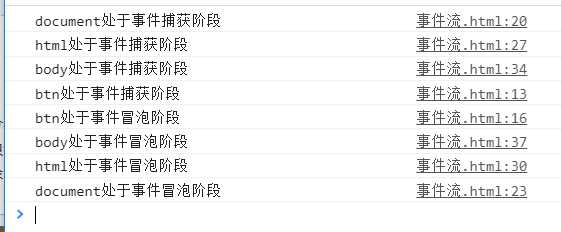
1,addEventListener
addEventListener是DOM2級事件新增的指定事件處理程序的操作,這個方法接收3個參數:要處理的事件名,作為事件處理程序的函數和一個布爾值,最後這個布爾值如果是true,表示在捕獲階段調用事件處理程序;如果是false,表示在冒泡階段調用事件處理程序。
2,document,documentElement和document.body三者之間的關系:
document代表的是整個html頁面,
document.documentElement代表是的<html>標簽。
document.body代表的是<body>標簽。
出現上圖結果的原因是:
在標準的“DOM2級事件”中規定,事件流首先是經過事件捕獲階段,接著是處於目標階段,最後是事件冒泡階段。這裏可以畫個圖示意一下:
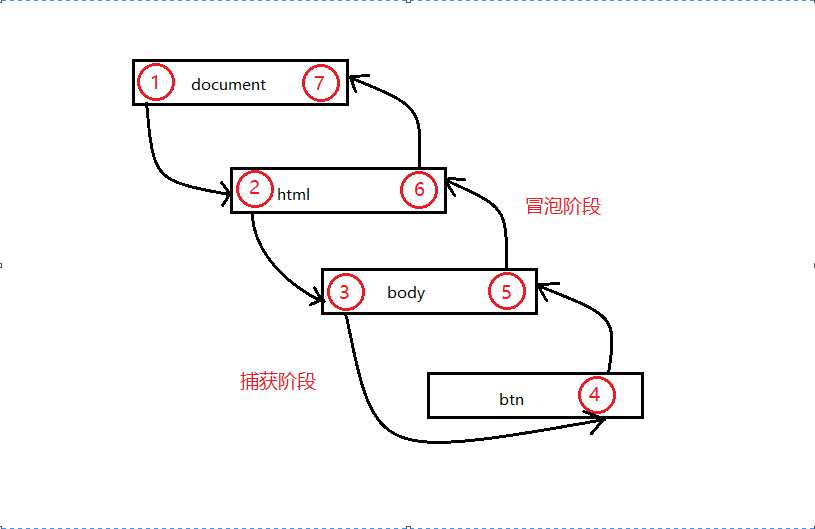
首先在事件捕獲過程中,document對象首先接收到click事件,然後事件沿著DOM樹依次向下,一直傳播到事件的實際目標。就是id為btn的標簽。
接著在事件冒泡的過程中,時間開始是由具體的元素(a標簽)接收,然後逐級向上傳播到較為不具體的節點。
jQuery的常用事件:
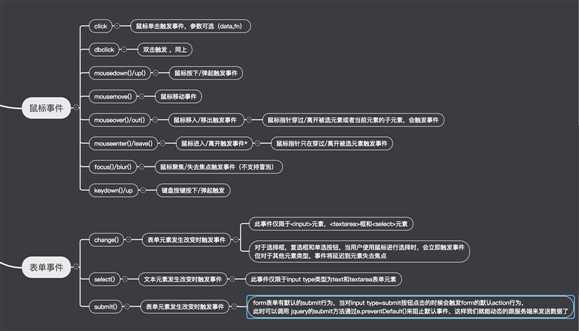
摘自https://www.cnblogs.com/lbjiu/
第十周web作業
